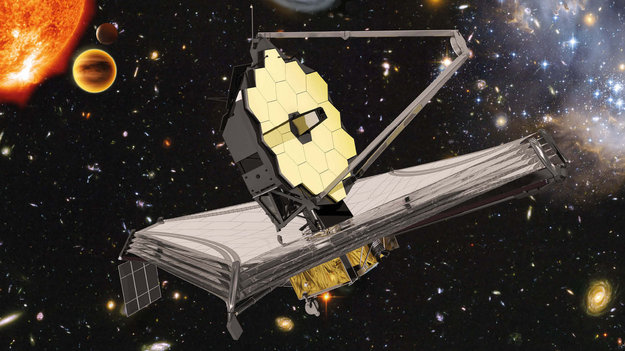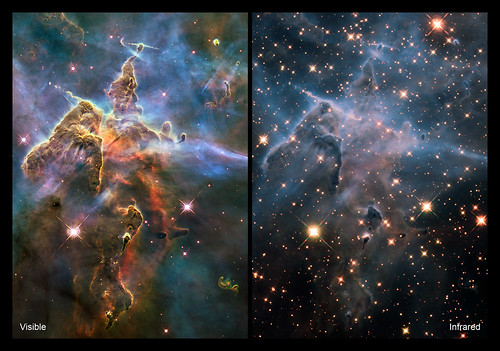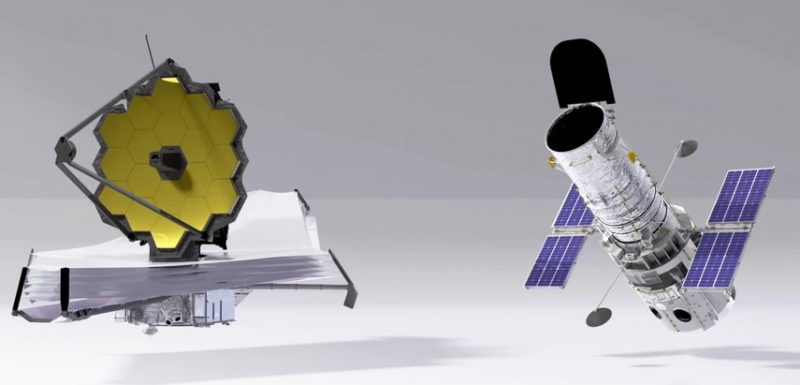
The Webb is Hubble’s successor
Rumors were swirling, and now it appears to be true. The James Webb Space Telescope – also known as JWST or simply the Webb – is coming up against yet another delay, albeit a small one in contrast to other delays and setbacks over the past two decades. European Space Agency representatives and Arianespace officials acknowledged at a briefing on June 1, 2021, that the launch of the Webb will likely slip from this coming October 31. According to SpaceNews, the cause of the delay is a grace period for team engineers to review payload fairing problems. The payload fairing is essentially the rocket’s nose cone. It’s the covering on top of the payload. The issue in this case is linked to the Ariane 5 rocket that’ll launch Webb, hopefully, now, in mid-November 2021.
During the briefing, Arianespace described the issue as “a less than fully nominal separation of the fairing” that occurred during two of its launches. In terms of rocketry, nominal means within expected and acceptable limits. Furthermore, Daniel de Chambure – acting head of Ariane 5 adaptations – said:
The qualification review has started, so we should be able to confirm all that within a few days or weeks.
Webb passed final testing in February
Space engineeers made significant progress in the development of the Webb earlier this year. In February 2021, two testing milestones – the comprehensive systems test and the ground segment test – confirmed that the observatory’s internal electronics are operating as intended. These tests also verified that it and its four science instruments can send and receive data.
The comprehensive systems test took place at Northrop Grumman in Redondo Beach, California, the industrial partner in the Webb project. Specifically, this test established a baseline of electrical functional performance for the entire observatory and all of the many components that work together in its composition. In other words, it’s the electrical version of the mechanical testing that successfully completed in October 2020.
The ground segment test was completed in collaboration with test engineers at the Space Telescope Science Institute in Baltimore, Maryland. This institute will operate the telescope after launch. That test was designed to simulate the complete process from planning science observations to posting the scientific data to the community archive. Jennifer Love-Pruitt, the Webb’s electrical vehicle engineering lead, said in a March 1, 2021, statement:
It’s been amazing to witness the level of expertise, commitment and collaboration across the team during this important milestone. It’s definitely a proud moment because we demonstrated Webb’s electrical readiness. The successful completion of this test also means we are ready to move forward toward launch and on-orbit operations.
Launch from near Earth’s equator
When the telescope launches, it will depart from the ELA-3 launch site at the European Spaceport located near Kourou, French Guiana. The massive observatory will then make its way to Lagrange Point 2, a gravitationally stable point 930,000 miles (1.5 million km) from our planet.
The Webb will then deploy its sunshield and begin studying the cosmos in infrared light using its dazzling golden mirror.

Webb Space Telescope’s long road
The Webb’s development began in 1996, with a $500 million budget. Space scientists and engineers initially planned the launch for 2007. But the project has had considerable delays and cost overruns, and it underwent a major redesign in 2005. Afterwards, they planned the launch for March 2020, but the coronavirus pandemic struck and has caused major setbacks. Yet, now, the team has made significant progress. NASA says existing program funding will have the Webb finished within its current $8.8 billion cost cap. In December 2020, the sunshield of a fully assembled James Webb Space Telescope successfully completed its own final tests, including a complete unfolding, just as the telescope will need to do once in space.
Formerly known as the Next Generation Space Telescope, scientists renamed the Webb in September 2002 after James Webb, who was an esteemed former NASA administrator.
The entire project is an international collaboration between NASA, the European Space Agency, and the Canadian Space Agency. NASA’s Goddard Space Flight Center in Greenbelt, Maryland, manages the development effort, while Northrop Grumman serves as the project’s main industrial partner.
As it did for the Hubble Space Telescope, the Space Telescope Science Institute in Baltimore will be operating the Webb telescope after launch.
What’s huge, grand, and golden?
One of the Webb’s most important and identifiable attributes is its 21-foot-wide (6.5-meter-wide) primary mirror. A reflecting telescope’s primary mirror determines how much light it can collect, and thus how deeply it can see into the universe. Webb’s mirror is nearly three times wider than Hubble’s primary mirror.
You might hear people speak of the Webb’s golden mirror. The mirror is actually multiple mirrors. It’s composed of 18 separate hexagonal-shaped segments made of very strong, ultra-lightweight beryllium, which will unfold after launch. Each of the telescope’s mirror segments are covered in a microscopically thin layer of gold. This gold covering optimizes the mirror segments for reflecting infrared light, which is the primary wavelength of light this telescope will observe.
Webb sunshield and more
The Webb’s biggest feature, however, is its tennis court-sized sunshield, designed to reduce the sun’s heat by more than a million times, to -364 degrees F (-220 degrees C). The purpose of the sunshield is to keep the mirror and instrumentation cold. If it were to be heated up by the sun, it would give off its own infrared radiation and drown out the faint infrared signals from the distant galaxies it’s meant to measure.
The Webb is equipped with four cameras and spectrometers with detectors able to record extremely faint signals. One of these, the Near InfraRed Spectrograph has programmable “microshutters” that let it observe up to 100 objects at the same time.
The detectors of one of the other instruments require even colder temperatures to function than the sunshield can provide, so a cryocooler keeps it at around -447 Fahrenheit (7 kelvin or -266 degrees C).

Technologies advance
As you would expect, the capabilities of the Webb extend beyond those of the Hubble Space Telescope. NASA likes to say that the Webb is not a replacement for Hubble, but rather a successor. The two telescopes will collaborate side by side for a while, with a planned overlap.
The Webb will observe farther into the infrared regions of the electromagnetic spectrum than Hubble. It’ll go even deeper into space than Hubble, and thus it’ll look further into the past. It’ll be able to peer inside stellar dust clouds where stars and star systems form. Thaddeus Cesari, a communications specialist for the mission, wrote:
In addition to the groundbreaking science expected from it after launch, Webb has required an improvement in the testing infrastructure and processes involved in validating large complex spacecraft for a life in space … Lessons learned from previous space telescope development were invested into Webb, and future space telescopes will be built upon the same collective knowledge. Thousands of scientists, engineers, and technicians contributed to build, test, and integrate Webb. In total, 258 companies, agencies, and universities participated: 142 from the United States, 104 from 12 European nations, and 12 from Canada.

Who will use the Webb?
The Webb will be the largest, most powerful and most complex infrared telescope ever built. Thousands of astronomers worldwide will use it for a wide range of research projects, complementing and extending the discoveries of the Hubble Space Telescope, as well as the now-decommissioned Spitzer infrared space telescope.
Once in space, above Earth’s obscuring atmosphere, the Webb is expected to provide unobstructed views of the near and distant cosmos. Since light has a finite speed (186,000 miles per second, or 300,000 km per second), the new space telescope will also provide insights into our universe’s past: from the first light after the Big Bang, to the formation and evolution of galaxies, to our own and other planetary systems.
Thus, the Webb will be used for study of every phase in the history of our universe.

Your new wallpaper
NASA selected 22 artists nationwide to attend the James Webb Space Telescope Artist Event at the Goddard Spaceflight Center in Greenbelt, Maryland. The artists sat directly in front of the Webb telescope while being briefed on the mission by scientists, engineers and other project personnel. As they listened, they worked; sketching, painting, writing, sewing, playing music. Visit this gallery to see their astonishing impressions of the Webb and its mission.
Bottom line: The James Webb Space Telescope is the world’s most complex infrared telescope. On June 1, 2021, European Space Agency representatives and Arianespace officials announced that the launch of the Webb will likely slip from October 31 to at least mid-November.
Read more from EarthSky: James Webb Space Telescope passes environmental testing
The post Webb Space Telescope launch delayed first appeared on EarthSky.
from EarthSky https://ift.tt/3vVbPv9

The Webb is Hubble’s successor
Rumors were swirling, and now it appears to be true. The James Webb Space Telescope – also known as JWST or simply the Webb – is coming up against yet another delay, albeit a small one in contrast to other delays and setbacks over the past two decades. European Space Agency representatives and Arianespace officials acknowledged at a briefing on June 1, 2021, that the launch of the Webb will likely slip from this coming October 31. According to SpaceNews, the cause of the delay is a grace period for team engineers to review payload fairing problems. The payload fairing is essentially the rocket’s nose cone. It’s the covering on top of the payload. The issue in this case is linked to the Ariane 5 rocket that’ll launch Webb, hopefully, now, in mid-November 2021.
During the briefing, Arianespace described the issue as “a less than fully nominal separation of the fairing” that occurred during two of its launches. In terms of rocketry, nominal means within expected and acceptable limits. Furthermore, Daniel de Chambure – acting head of Ariane 5 adaptations – said:
The qualification review has started, so we should be able to confirm all that within a few days or weeks.
Webb passed final testing in February
Space engineeers made significant progress in the development of the Webb earlier this year. In February 2021, two testing milestones – the comprehensive systems test and the ground segment test – confirmed that the observatory’s internal electronics are operating as intended. These tests also verified that it and its four science instruments can send and receive data.
The comprehensive systems test took place at Northrop Grumman in Redondo Beach, California, the industrial partner in the Webb project. Specifically, this test established a baseline of electrical functional performance for the entire observatory and all of the many components that work together in its composition. In other words, it’s the electrical version of the mechanical testing that successfully completed in October 2020.
The ground segment test was completed in collaboration with test engineers at the Space Telescope Science Institute in Baltimore, Maryland. This institute will operate the telescope after launch. That test was designed to simulate the complete process from planning science observations to posting the scientific data to the community archive. Jennifer Love-Pruitt, the Webb’s electrical vehicle engineering lead, said in a March 1, 2021, statement:
It’s been amazing to witness the level of expertise, commitment and collaboration across the team during this important milestone. It’s definitely a proud moment because we demonstrated Webb’s electrical readiness. The successful completion of this test also means we are ready to move forward toward launch and on-orbit operations.
Launch from near Earth’s equator
When the telescope launches, it will depart from the ELA-3 launch site at the European Spaceport located near Kourou, French Guiana. The massive observatory will then make its way to Lagrange Point 2, a gravitationally stable point 930,000 miles (1.5 million km) from our planet.
The Webb will then deploy its sunshield and begin studying the cosmos in infrared light using its dazzling golden mirror.

Webb Space Telescope’s long road
The Webb’s development began in 1996, with a $500 million budget. Space scientists and engineers initially planned the launch for 2007. But the project has had considerable delays and cost overruns, and it underwent a major redesign in 2005. Afterwards, they planned the launch for March 2020, but the coronavirus pandemic struck and has caused major setbacks. Yet, now, the team has made significant progress. NASA says existing program funding will have the Webb finished within its current $8.8 billion cost cap. In December 2020, the sunshield of a fully assembled James Webb Space Telescope successfully completed its own final tests, including a complete unfolding, just as the telescope will need to do once in space.
Formerly known as the Next Generation Space Telescope, scientists renamed the Webb in September 2002 after James Webb, who was an esteemed former NASA administrator.
The entire project is an international collaboration between NASA, the European Space Agency, and the Canadian Space Agency. NASA’s Goddard Space Flight Center in Greenbelt, Maryland, manages the development effort, while Northrop Grumman serves as the project’s main industrial partner.
As it did for the Hubble Space Telescope, the Space Telescope Science Institute in Baltimore will be operating the Webb telescope after launch.
What’s huge, grand, and golden?
One of the Webb’s most important and identifiable attributes is its 21-foot-wide (6.5-meter-wide) primary mirror. A reflecting telescope’s primary mirror determines how much light it can collect, and thus how deeply it can see into the universe. Webb’s mirror is nearly three times wider than Hubble’s primary mirror.
You might hear people speak of the Webb’s golden mirror. The mirror is actually multiple mirrors. It’s composed of 18 separate hexagonal-shaped segments made of very strong, ultra-lightweight beryllium, which will unfold after launch. Each of the telescope’s mirror segments are covered in a microscopically thin layer of gold. This gold covering optimizes the mirror segments for reflecting infrared light, which is the primary wavelength of light this telescope will observe.
Webb sunshield and more
The Webb’s biggest feature, however, is its tennis court-sized sunshield, designed to reduce the sun’s heat by more than a million times, to -364 degrees F (-220 degrees C). The purpose of the sunshield is to keep the mirror and instrumentation cold. If it were to be heated up by the sun, it would give off its own infrared radiation and drown out the faint infrared signals from the distant galaxies it’s meant to measure.
The Webb is equipped with four cameras and spectrometers with detectors able to record extremely faint signals. One of these, the Near InfraRed Spectrograph has programmable “microshutters” that let it observe up to 100 objects at the same time.
The detectors of one of the other instruments require even colder temperatures to function than the sunshield can provide, so a cryocooler keeps it at around -447 Fahrenheit (7 kelvin or -266 degrees C).

Technologies advance
As you would expect, the capabilities of the Webb extend beyond those of the Hubble Space Telescope. NASA likes to say that the Webb is not a replacement for Hubble, but rather a successor. The two telescopes will collaborate side by side for a while, with a planned overlap.
The Webb will observe farther into the infrared regions of the electromagnetic spectrum than Hubble. It’ll go even deeper into space than Hubble, and thus it’ll look further into the past. It’ll be able to peer inside stellar dust clouds where stars and star systems form. Thaddeus Cesari, a communications specialist for the mission, wrote:
In addition to the groundbreaking science expected from it after launch, Webb has required an improvement in the testing infrastructure and processes involved in validating large complex spacecraft for a life in space … Lessons learned from previous space telescope development were invested into Webb, and future space telescopes will be built upon the same collective knowledge. Thousands of scientists, engineers, and technicians contributed to build, test, and integrate Webb. In total, 258 companies, agencies, and universities participated: 142 from the United States, 104 from 12 European nations, and 12 from Canada.

Who will use the Webb?
The Webb will be the largest, most powerful and most complex infrared telescope ever built. Thousands of astronomers worldwide will use it for a wide range of research projects, complementing and extending the discoveries of the Hubble Space Telescope, as well as the now-decommissioned Spitzer infrared space telescope.
Once in space, above Earth’s obscuring atmosphere, the Webb is expected to provide unobstructed views of the near and distant cosmos. Since light has a finite speed (186,000 miles per second, or 300,000 km per second), the new space telescope will also provide insights into our universe’s past: from the first light after the Big Bang, to the formation and evolution of galaxies, to our own and other planetary systems.
Thus, the Webb will be used for study of every phase in the history of our universe.

Your new wallpaper
NASA selected 22 artists nationwide to attend the James Webb Space Telescope Artist Event at the Goddard Spaceflight Center in Greenbelt, Maryland. The artists sat directly in front of the Webb telescope while being briefed on the mission by scientists, engineers and other project personnel. As they listened, they worked; sketching, painting, writing, sewing, playing music. Visit this gallery to see their astonishing impressions of the Webb and its mission.
Bottom line: The James Webb Space Telescope is the world’s most complex infrared telescope. On June 1, 2021, European Space Agency representatives and Arianespace officials announced that the launch of the Webb will likely slip from October 31 to at least mid-November.
Read more from EarthSky: James Webb Space Telescope passes environmental testing
The post Webb Space Telescope launch delayed first appeared on EarthSky.
from EarthSky https://ift.tt/3vVbPv9

Aucun commentaire:
Enregistrer un commentaire